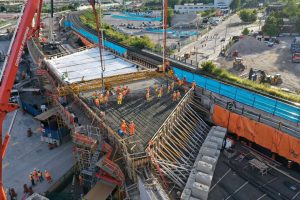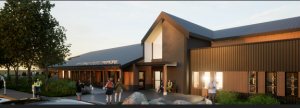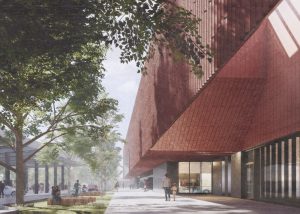The long-awaited Toronto Life Square, a 360,000-square foot, 10-storey mixed-use project at the corner of Dundas and Yonge Streets, will finally opening its doors this spring.
Finding tenants for unique space just one of the challenges overcome by developer PenEquity Management
The long-awaited Toronto Life Square, a 360,000-square foot, 10-storey mixed-use project at the busy corner of Dundas and Yonge Streets, is finally opening its doors this spring after about a dozen years in the making.
Easily recognizable by the 20,000 square feet or so of electronic advertising billboards cladding its exterior, the complex features a host of retail/entertainment stores anchored by a 24-screen AMC theatre complex.
Assembling the project proved anything but easy for the developer.
“It was a very unusual job for us, but I don’t think there would have been anything common about it for any developer in Canada,” says Leger Xavier, of Toronto-based PenEquity Management Corporation.
Originally called Metropolis, the development faced a series of financing and marketing setbacks in the 1990s and earlier this decade before construction finally got rolling in the fall of 2005.
“The challenge has really been to try to stabilize the tenancy program, given that the design couldn’t be flexible for every tenant’s needs,” says Xavier, PenEquity’s vice-president of development and leasing.
Securing major tenants was a particularly trying task in the early days of the development’s history, explains Xavier.
The high-profile location in the heart of the city proved to be “a double-edged sword” because while it drew interest from big names like Virgin and Disney, uncertainty surrounded the development when those tenancy deals fell through.
“We lost a lot of real estate deals to people who through market chatter decided they would either go to another part of the city … or inside the stable asset at the time, which was the Eaton Centre (across the street).”
“That is part of market reality and the risk we take on as developers,” Xavier points out.
PenEquity purchased the property in 1999. PCL Constructors Canada Inc. started building the $90 million project in the fall of 2005. Several years earlier, Vanbots Construction Corporation built the substructure before the development was put on hold because of financing woes.
A construction challenge was dealing with ever-changing interior configurations, resulting from a flurry of tenancy changes.
“We had to try and keep the design flexible but a multi-storey, multi-use building is hard to keep flexible unless you are ready to allow for every possible combination of tenancy,” explains Xavier. “That wasn’t something that would be economically feasible.”
“When we integrated the changes for Adidas (a specialty store for the running shoe manufacturer) and Shoppers Drug Mart and Extreme Fitness, for instance, we were still dealing with infrastructure setup for Virgin.”
The building team also had to push to get the Future Shop settled into its new digs last November — before the rest of the building was ready for occupancy. To complete the task, a fire alarm and smoke evacuation system was specifically created for the store. Another challenge was securing clients for the large, flexible electronic signage boards on the exterior. In the late 1990s to early 2000s, the only billboard ads in Toronto were along the side of freeways like the Gardiner Expressway. Selling the idea of advertising on downtown buildings wasn’t easy.
“It took a lot of effort to promote our idea and the rates we had were obviously much higher than they were used to seeing,” says Xavier, adding that designing flexibility into the advertising boards to allow client’s maximum creativity required a lot of work.
The advertising boards, which are a combination of static and active video boards, include Canada’s largest high-definition video display, a 30- by 52-foot screen.
The signage is accented by zinc-panel cladding and exposed air ducts and fans — part of the industrial theme emphasized by project architect Baldwin & Franklin Architects Inc. Young + Wright Architects Inc. designed the AMC theatre complex.
The first four floors of the structure are cast-in-place concrete with the upper floors comprised of structural steel and metal decks. Like many downtown Toronto construction sites, the development had minimal laydown area, so building material deliveries were on a just-in-time basis. The steel, which was jointly fabricated by Walters Inc. and Structal, was stored in Hamilton and shipped during early morning hours when traffic was light.
Ryerson University will use of about half of the AMC cinemas as lecture halls during mornings and afternoons. To control pedestrian flow and deal with security issues, card readers, mag locks and security cameras are required.
Xavier says he thinks the tenant mix in the building today is a substantial improvement on the client base targeted back in the late 1990s when the top ten tenants were “extremely hot” entertainment-geared retailers. Since then, roughly 90 percent of those retailers have gone bankrupt.
Luck, perhaps, has been on PenEquity’s side.











Recent Comments
comments for this post are closed